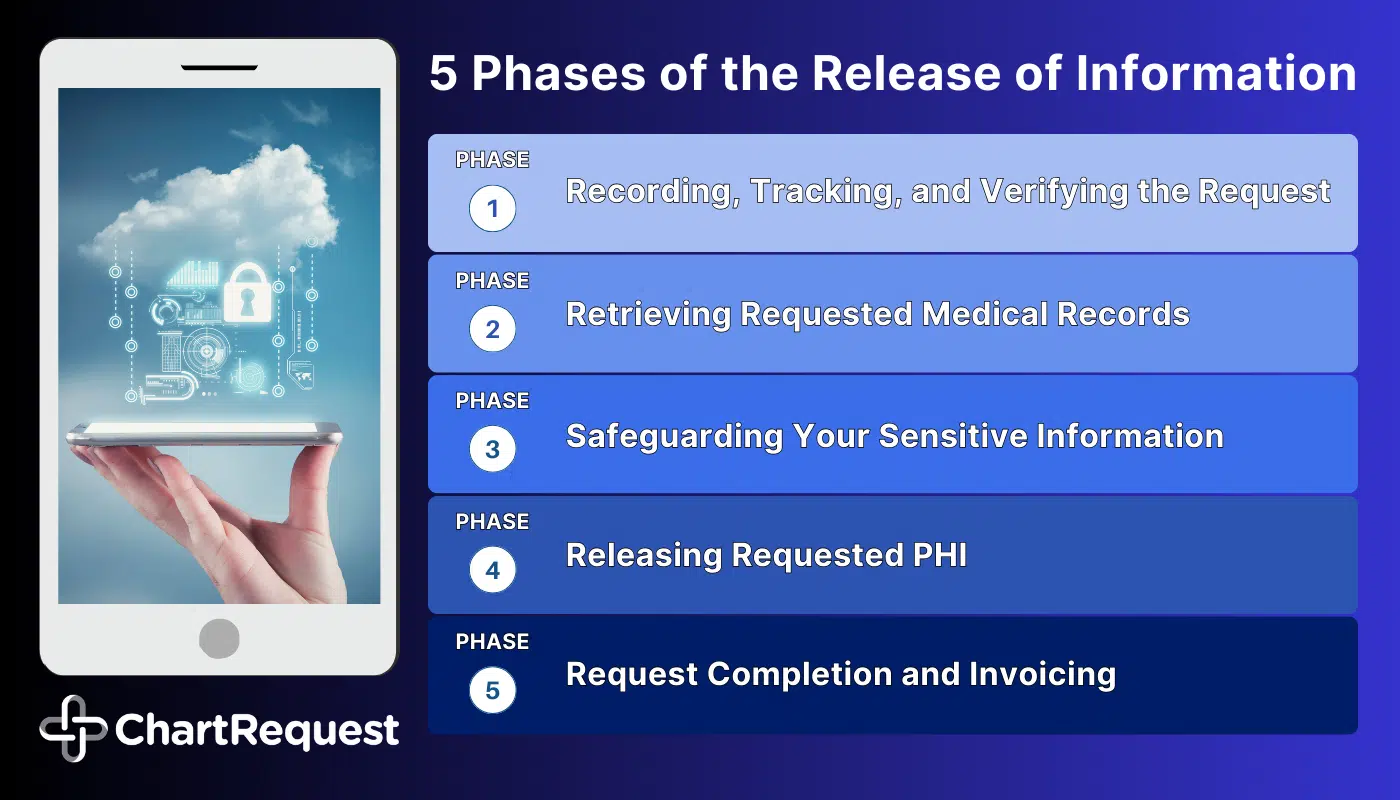If you’re reading this article, you likely want to learn the meaning of ROI in medical settings. The financial acronym of ROI as return on investment is far more well known, but it’s not the only one.
The primary meaning of ROI in medical settings is the release of information. This most commonly refers to the sharing of medical, billing, and information records or other PHI.
While the release of information sounds simple at its core, it’s actually a highly regulated administrative task. Truly understanding the meaning of ROI in medical settings and its role across the healthcare industry takes some additional context.
In this article, we’ll cover some release of information basics, including why it’s important, what makes it so complicated, and the true meaning of ROI in medical practices.
Why Do People Request the Release of Information?
Medical records can be requested by various individuals and entities for a variety of reasons. Here is a breakdown of the different types of medical records requestors and the potential reasons behind their requests:
Patients or their representatives make up a large portion of most organizations’ incoming ROI requests. In some cases, patients will keep a personal health record to expedite care and stay involved in their health.
Patients with a PHR don’t need to wait for ROI, meaning medical care can be more efficient and informed. This also helps speed up payments in situations where medical records are needed for a legal or insurance claim.
Healthcare providers usually request medical records when it’s time to refer patients or coordinate care with another provider. While healthcare organizations may charge for the release of information to most types of requestors, they cannot charge other providers.
Some healthcare providers also request records for research purposes, but ROI guidelines are different in this situation.
Attorneys and legal representatives often submit subpoena requests for medical records related to a case. Common cases that require ROI for medical records include personal injury, medical malpractice, disability, and worker’s compensation.
Like attorneys, insurance companies also request medical records for cases they’re working on. Additionally, some insurance companies need to review medical records to determine if treatment is medically necessary for pre-authorization.
Finally, government agencies may request records to evaluate and process benefit claims and to conduct compliance audits. During an audit, healthcare providers often drown in requests as they work to keep up with substantially increased ROI obligations.
What Does the ROI Process for Medical Records Look Like?
The meaning of ROI in medical practices usually refers to the release of information process. Healthcare organizations may also use it interchangeably to mean their record release team.
If you currently are or may become part of an ROI department, you need a firm understanding of the process. The release of information process consists of more than 40 steps, but we can divide these steps into five phases.

Phase 1: Recording, Tracking, and Verifying the Authorization
The release of information usually begins when requestors fill out a HIPAA-compliant authorization form in accordance with the Privacy Rule. In most cases, this authorization form gives the healthcare organization the authority to release the requested records.
Upon receiving a request for PHI, a 30-day timer begins before the organization may incur Right of Access Initiative penalties. In some states, this mandatory turnaround deadline is even shorter.
When releasing PHI, it’s important to diligently track every part of the ROI process to protect your organization in the case of an audit. Additionally, you must document requests that do not require patient authorization in an Accounting of Disclosures.
Phase 2: Retrieving Requested Medical Records for ROI
Once an organization verifies a signed authorization form, it’s time to prepare the PHI. In the authorization form, the requestor will outline the date range and nature of the treatment.
The provider should follow the minimum necessary standard, meaning they only collect medical records specifically requested for ROI. Keep in mind that requestors may request all records on file without listing out each visit, as “All” is specific.
An ROI professional then searches for the medical records. These records may be a paper, microfilm, or electronic format and may be located onsite or offsite. In rare cases, an organization may have to retrieve a combination of all three formats from multiple locations.
Phase 3: Safeguarding Your Sensitive Information
The ROI professional who retrieved the medical records carefully examines every image or page. If the request does contain PHI they cannot legally release, they reject the request and update the requestor. If it doesn’t, they double-check that all pages, images, and dates of service are correct.
To avoid any errors, the ROI team at ChartRequest performs a double-QA process with two different people each verifying accuracy.
Phase 4: Releasing Requested PHI
When it’s time to release requested records, the ROI department must be careful. Security and compliance restrict how healthcare providers can release records.
In addition to these restrictions, ROI staff must be careful to avoid engaging in information blocking per the Cures Act. After all, the meaning of ROI in medical settings is the release of protected health information.
To protect healthcare providers from feeling forced to unlawfully release records, the Cures Act includes 8 information blocking exceptions.
Phase 5: Request Fulfillment and Invoicing
Once requested records are ready for release, the ROI team can price billable requests. Cost calculation is based on a combination of federal, state, and local statutes that limit the maximum lawful price.
This is a complicated process, meaning some organizations choose to not charge their reasonable, cost-based ROI fees for medical records. To help healthcare providers collect ROI revenue, ChartRequest created and maintains a best-price algorithm and streamlines the billing process.
After an ROI professional releases the requested records, it’s time to begin working on the next medical records request. The ROI process can take medical professionals hours with traditional methods like fax, which makes keeping up with requests challenging.
Learn More About the Meaning of ROI in Medical Settings
In summary, the meaning of ROI in medical settings refers to the release of information, which involves sharing medical records. This process is complex and regulated, with people submitting requests for a wide variety of reasons.
When asked about the meaning of ROI in medical settings, however, healthcare providers think about more than just sending PHI. The ROI process consists of multiple phases, and each phase is filled with smaller steps toward releasing medical records.
The ROI process has traditionally been disjointed and time-consuming, unfortunately, relying on outdated methods like faxing and snail mail. We designed ChartRequest to revolutionize ROI by streamlining the ROI process and overcoming common challenges with medical records exchange.
By releasing medical records with ChartRequest, healthcare organizations can optimize their ROI workflows, protect patient privacy, ensure compliance, and more. Ready to learn more about how our release of information software changes the meaning of ROI in medical organizations?


